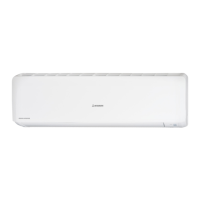
Do you have a question about the Mitsubishi Heavy Industries SRK63ZRA-W and is the answer not in the manual?
| Cooling Capacity | 6.3 kW |
|---|---|
| Heating Capacity | 7.1 kW |
| Power Supply | 220-240V, 50Hz |
| Energy Star Rating Cooling | Yes |
| Energy Star Rating Heating | Yes |
| Refrigerant | R32 |
| Type | Split System |
| Noise Level (Outdoor Unit) | 52 dB(A) |
Essential guidelines for safely installing the air conditioner unit.
Crucial warnings and cautions for safe operation of the air conditioner.
Safety measures and precautions for moving or repairing the air conditioner.
Details and descriptions of the various parts of the indoor air conditioner unit.
Details and descriptions of the various parts of the outdoor air conditioner unit.
Explanation of the remote control's display indicators and included accessories.
Step-by-step guide for inserting and setting up batteries in the remote control.
Instructions for using the remote control holder and important usage warnings.
How to operate the unit temporarily when the remote control is unavailable.
Instructions on adjusting the airflow direction based on installation location for optimal comfort.
Detailed explanation of each button on the remote control and its operation.
Procedure for setting the current day of the week and time on the remote control.
How the unit automatically selects operation modes based on room temperature.
Adjusting the temperature settings specifically when the unit is in AUTO mode.
Guide on how to select and adjust the fan speed for optimal airflow.
Instructions for operating the air conditioner in COOL, HEAT, DRY, and FAN modes.
Recommended operating temperature ranges for optimal performance and protection.
Explanation of how the HEAT mode functions, including defrosting.
How to adjust the up/down and left/right airflow directions for comfort.
Guide to the 3D AUTO operation for efficient air distribution.
How to set the timer for the unit to stop automatically after a set period.
How to set the timer for the unit to stop automatically at a specific time.
How to set the timer for the unit to start automatically at a specific time.
Instructions for using both SLEEP and ON timers simultaneously.
How to use both ON and OFF timers together for scheduled operation.
Using the unit's function to eliminate allergens from the air.
Guide to setting up automated operation schedules for each day of the week.
How to activate or deactivate the weekly timer function using the remote.
Setting specific programs for individual days of the week.
Applying the same program settings across multiple days of the week.
Procedures for cancelling individual or collective timer settings.
How to check the currently programmed weekly timer settings.
Using high power for quick cooling/heating and ECO for energy saving.
Maintaining a comfortable temperature during nighttime or absence.
Reducing noise levels for quieter operation.
Running a self-cleaning cycle to remove moisture and prevent mold.
How the unit resumes operation after a power interruption.
General advice for economical and comfortable unit usage.
Step-by-step guide for removing and cleaning the air filters.
Instructions for cleaning the main unit and the air inlet panel.
Tasks to perform at the end and beginning of the operating season.
Information on inspecting, cleaning, and replacing air-cleaning filters.
Recommendations for choosing the best location for unit installation.
How to minimize operating noise and vibration during installation.
Importance of periodic inspection and maintenance after installation.
A guide to diagnosing and resolving common operational problems.
Specific notices related to airflow behavior during different operations.
Explanations for various operational noises the unit might produce.
Other important information and operational notes for the air conditioner.
Interpreting error codes indicated by the RUN and TIMER lights for fault diagnosis.
Information on the Demand Response Enabling Devices (DRED) mode compatibility.
